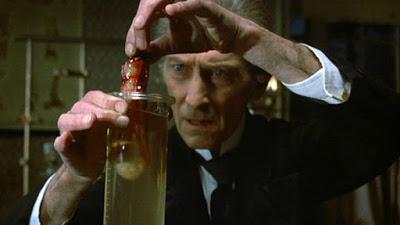Format: Turner Classic Movies on rockin’ flatscreen.

It’s hard not to love Peter Cushing and Christopher Lee films from the ‘50s through the ‘70s. They’re campy and silly and loaded with cheese, and our two heroes always play things so seriously. It takes a certain kind of actor to be able to say ridiculous lines and work with ridiculous props without becoming ridiculous himself. These two could do it. They elevate the material they are given to work with. In the case of a film like The Creeping Flesh, that ability to elevate the material is going to be important.
This is a typical early-mid 1970s British horror film in a lot of respects. We’re going to jump back in time to the late Victorian period where so much Brit horror seems to be centered. There’s something very interesting about those just post-industrial years where, with a little bit of tweaking, we could have all been living in a steampunk future. Anyway, The Creeping Flesh is right there at the crossroads of the early stages of modern technology and the end of more barbaric eras of medicine and mental health care.
Anyway, we start with Emmanuel Hildern (Peter Cushing), who has just returned from an exploration of Papua New Guinea where he has discovered a gigantic humanoid skeleton. This skeleton was buried at a strata much lower than other discoveries, but appears to be much further advanced than skeletons found at more recent strata. Hildern hopes that investigating this new discovery will win him a prestigious scientific prize, but also learns on his return that his wife, who has been institutionalized for years, has died. It’s worth noting that she was being held in an institution run by Emmanuel’s brother James (Christopher Lee).
The skeleton has a unique property: it regrows flesh when it encounters water, discovered when Emmanuel attempts to clean the skeleton and the flesh regrows on a finger. He looks through the literature of the people in the area and discovers a myth concerning giant, evil creatures that will someday be revived by rain. He removes the fleshy finger and begins investigating it, discovering a unique form of red blood cell. From this, Emmanuel determines that the evil of these creatures is actually a blood-borne illness, and thus a vaccine can be created. He attempts to do so, and appears initially to be successful. Concerned that his daughter Penelope (Lorna Heilbron) will follow his wife into madness, he inoculates her (he thinks) against this evil.
Sadly, the vaccine proves to be a bust, and the monkey used in the initial experiment goes berserk, which then happens with poor Penelope. She eventually winds up in the asylum run by James, who soon discovers the weird blood-borne parasite. Drawing a conclusion that Emmanuel has done something very bad, he essentially steals the skeleton and commandeers his brother’s research, hoping to win the prestigious scientific award for himself.
It’s all pretty weird and is entertaining in spite of itself and in spite of the rather ridiculous giant skeleton, which looks like something put together with plaster of Paris by prop people new to the job. What is unconscionable is the path the movie takes in its final minutes. I need to discuss this, but that requires a spoiler tag.
*** LIKE GREMLINS, WATCH OUT FOR WATER ***
The entire plot of the movie could be summed up by simply calling this The Creeping Flesh of Dr. Caligari. It’s a little disappointing that we go through all of this for a twist at the end that feels like a cobble and a cop out. It’s as if the writers wrote themselves into a corner and didn’t have anywhere else to go.
*** WIPE UP THAT WATER SPILL! ***
The Creeping Flesh seems to want to dive into prurient realms, but never really gets there. When Penelope starts to go berserk, she does so by more or less following her mother’s footsteps, hanging around in seedy bars and looking for all the world like one of the prostitutes that seems to hang out in the bar in question. She’s eventually dragged upstairs by one of the patrons, who is naturally upset that she’s not that forthcoming with the sex. The scene certainly seems to want to lead us to nudity, but it never gets there. The film wants to trade on the sort of cheap thrills that the genre often demands, but it doesn’t go there, which is again, a little disappointing.
Ultimately, The Creeping Flesh has some interesting ideas, but it can’t really pull any of them off. It’s not the film it should be or the film it wants to be, and for that, it’s a hard film to recommend. Lee and Cushing are always great, and whether they are on the same team or facing off as adversaries, it’s great to see them on camera together. But they made better movies with better plots, and those are the ones worth watching.
Why to watch The Creeping Flesh: Christopher Lee and Peter Cushing cure a lot of ills.
Why not to watch: It’s depressingly derivative at the end.
